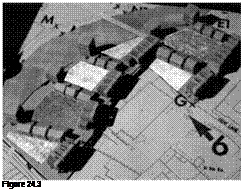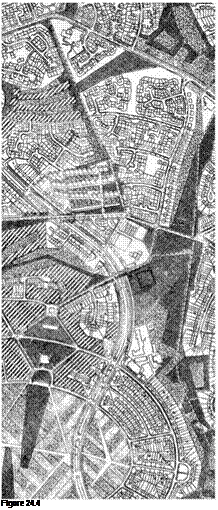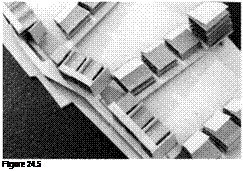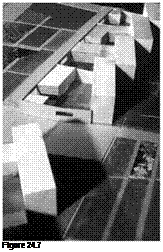It is reasonable to expect that during the first stages of implementation of CPULs, a series of small interventions will, be made, eventually leading to an extensive network of connected spaces. Such
Figure 24.2 Victoria Park CPUL: Small pieces of land, such as this one between two live/work units, can accommodate micro fields that are productive but domestic in character.
 |

an approach will, over time, create a sense of openness within an otherwise uniformly built and occupied environment. Figure 24.4 shows the outcome of this kind of strategy, whereby over time disused and abandoned sites become activated and used in an environmentally and socially productive manner. Here, productive landscapes occupy interstitial spaces found in the gaps between a predetermined urban grid. Meaning and a sense of openness are introduced to the site by delineating expansive views and long vistas, to what would otherwise remain a series of isolated, disconnected and largely disused patches of land.
CPULs or patches of productive urban landscapes can provide space for wondering eyes, and receptive ears. Spaces to view fields overlooking a horizon can be created within modest developments. Figures 24.5 and 24.6 show urban agriculture fields in Newark, set between housing terraces. Windows from within, and the paths alongside these houses, offer views across fields and sky. These proposals
Figure 24.3 Newark CPUL: Urban agriculture fields are situated like courtyards between housing and a river.
Figure 24.4 ElastiCity CPUL, Sheffield: In a strategy for developing CPULs over time, disused and abandoned sites become activated and reused in an environmentally and socially productive manner, creating a comprehensible and useful environment.


 |
courtyard, access is provided to a linear landscape, accommodating a mix of small and large patches of urban agriculture and recreational spaces. The height and size of boundaries guide eye and body through and across the landscape. Plate 13 shows how the eye is drawn from within to without, a condition that reoccurs at a variety of scales.
embody characteristics described in the Edge Atlas (see Chapter 17-Edge atlas).
The scale at which these conditions are experienced can be varied according to the degree to which occupation is in the private or public realm. In our proposals for Sheffield, (see Figure 24.7) the insertion of a courtyard into a dwelling allows eyes and occupants to move between interior and exterior within the domestic realm. Through this



